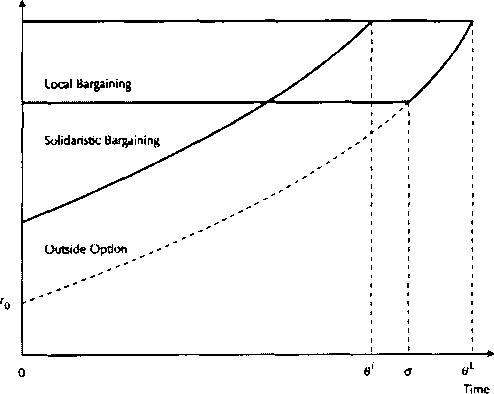Solidaristic Wage Bargaining
85
figure 2
Time Path of Wages with Local Bargaining

than σ but younger than θc pay workers
their outside option. The time path of wages
in a single plant with local bargaining is illu-
strated in Figure 2. The upper horizontal line
represents the revenues earned by a plant of a
given vintage. If workers' outside option rises
with the average level of productivity in the
economy, the outside option will be a expo-
nentially rising curve as drawn. As long as
the wage exceeds workers' outside option,
the wage in each plant is constant over time
since the negotiated wage depends on the
price, which is constant by assumption, and
productivity, which is determined by the
date the plant was built. As the plant grows
older and the outside option rises, the gap
between the union wage and workers' outsi-
de option falls. Eventually, at ɑ in Figure 2,
the outside option becomes binding and the
wage increases with r.
Since the wage with local bargaining
equals the outside option after the period ɑ,
the exit decision is to scrap the plant when
the value added per worker equals the outsi-
de option wage. Accordingly, the lifespan of
plants with local bargaining is independent
of the unions' share of the plant's revenue.
All plants pay a wage equal to workers' outsi-
de option once they get sufficiently old,
regardless of the bargaining power of the
local union. Although decentralized bargai-
ning does not affect firms' exit decision,
entry is discouraged. A higher union share
reduces the market value of new plants, since
the profits earned when the wage is higher
than the outside option are lower. A lower
value of new plants leads to fewer entrants.
As the number of plants that are constructed
each period declines, so does the industry's
output and employment.
With sunk costs of investment, the
union is able to appropriate some of the qua-
si-rents (the difference between the plant's
revenue and workers' outside option) earned
by the firm. Anticipation of the union's futu-
re bargaining strength causes firms to reduce
investment, which lowers aggregate employ-
ment. $ But once a plant is built, both the
employer and the local union have a com-
mon interest in maximizing the quasi-rents
More intriguing information
1. The name is absent2. The name is absent
3. The Challenge of Urban Regeneration in Deprived European Neighbourhoods - a Partnership Approach
4. Gender stereotyping and wage discrimination among Italian graduates
5. The name is absent
6. The name is absent
7. The name is absent
8. Rent Dissipation in Chartered Recreational Fishing: Inside the Black Box
9. The Social Context as a Determinant of Teacher Motivational Strategies in Physical Education
10. The Economic Value of Basin Protection to Improve the Quality and Reliability of Potable Water Supply: Some Evidence from Ecuador